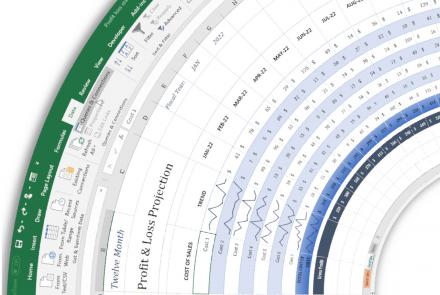
Resource Management: The Missing Puzzle Piece In Project Management Apps
Project management apps and software offer various features that historically deliver extraordinary results to a business. Namely, project managers benefit significantly from garnering a firm handle on their people, ongoing work, and overall objectives.
Through such tools, team efficiency, productivity, and profitability often soar, especially as organizations fully embrace the project management apps for all their nuance. Even beyond project management, the possibilities seem endless when a workforce wholeheartedly commits and learns the nitty-gritty detail of productivity-enhancing software.
Perhaps, those endless possibilities make it so that those same forward-thinking organizations notice gaps in these tools. For instance, while project management apps are a necessity for today’s fast-paced climate, they haven’t always shone in one specific aspect: Resource Management.
Project and Resource Management should frequently come together as one. After all, team leads can’t manage projects optimally without well-managed resources (aka, their team members).
Fortunately, the developers of Microsoft 365 noticed this particular pain point. More specifically, Microsoft Project Online Resource Management tools help manage cost, work, and material resources. Due to these cutting-edge features, there’s heightened efficiency and productivity with many tasks, such as:
- Adding and building teams
- Resource allocation
- Modifying, approving, and rejecting requests for resource engagement
Below, this article will break down the various aspects of Microsoft Project Online Resource Management in more granular detail.
What Is Microsoft Project Online?
Before delving into Microsoft Project Online Resource Management aspects, it’s crucial to answer, “what is Microsoft Project Online?”
So, what is Microsoft Project Online? For starters, it’s software rooted in everyday work and Project Portfolio Management (PPM).
The robust planning, managing, and prioritizing capabilities of Project Online revolve around project management and project portfolio investments. The features are accessible from nearly all devices and are usable for:
- Project and resource managers
- Team leads
- Team members
- Administrators
- Portfolio managers
- Portfolio viewers
Developed on the SharePoint platform, Project Online also stores data in SharePoint’s data store.
Detailed below are the features available and how you can get started with or use them:
Resource Request Reviews

The Microsoft Project Online Resource Management capabilities let team members know if they should reject, accept, or alter resource engagement requests.
When project managers submit requests, users must navigate to the Resource Center to review requests. In a resource list, requests get listed as Proposed, and users can check the resource box and choose to Accept if everything adds up correctly.
The resource in question then gets released back to the project manager, and they’ll assign it based on tasks that suit the request.
Users can switch out generic resources for something more specific. For example, a developer (a more generic role) can be swapped out for someone the project managers know fits the request parameters and is available.
Adding and Building Teams

Your team is like family, filled with individual people with unique personalities and skill-sets that set them apart. Interestingly, those human elements combined with technical expertise make each team member assets to the business.
After all, employees–among their many traits–are walking-talking company resources and are the human assets assigned to given tasks and projects. Thus, the highly talented people in your company fall firmly under the purview of Resource Management.
With Microsoft Project Online Resource Management, the first order of business is adding each team asset.
Adding Team Assets
Most–if not all–of your team need Project Online access and a license to view their given tasks, enter their progress, and submit timesheets. Add all necessary parties as Project Online users individually. Both in-house team members and third-party contractors or temporary employees fit the bill for access.
Here’s how to add each member:
After selecting Admin in the Microsoft 365 Business admin center, choose Users in the left pane. Then, select Active Users, and you’ll arrive on the Active Users page, where you’ll click on ,Add a User.
The New User dialog box possesses fields including name, account password info, contact info, Project Online license info, and role. Fill these fields in, then select Save before ensuring you’ve checked the Send Password in Email box in the User Was Added dialog box.
Input any email addresses within the textbox and select Send email before closing. Clear the checkbox, then click on Close if it’s preferable not to email the password.
Note that it’s possible to automatically import users and their contact info if your business uses Exchange or Active Directory. If this option piques your interest, contact JPSC for further insights on the matter.
Now it’s time to head over to the Project Online Resource Center for the next step in the team-building process.
Setting Up Your Resources
You must identify all users as resources in Project Online within your business’s project resource pool. It’s then possible to assign tasks to team members. You can also add them to project teams.
Here’s how to identify each team member as a resource:
Select Project in the app launcher and choose Resources on the Quick Launch before choosing New on the Resources tab.
Check the Associate Resource With a User Account box in the Identification Information section.
Then, in the User Logon Account box found in the User Authentication section, type the user’s email address or name it the same as it is in the admin center. Enter any remaining information about the team member/resource, and select Save to add a user to the Resource Center. Repeat these steps once more for each additional user classified as a resource.
With the foundation laid, it’s now possible to build your team.
Building Your Team
With users identified as resources, project managers can assign them to projects as team resources. Here’s how to do it:
After navigating to the Project Center in MS Project Online, select Projects, then type in the assigned team name.
In the Navigate group on the Project tab, click on Build Team. You’ll see the entire MS Project Online resource pool on the left of the Build Team page, whereas the right side is blank, waiting for you to fill it with the team resources allocated toward the given project. Check the boxes next to the names of the people you’re adding to the team.
Click on Add between the two tables. Then, choose Save & Close on the Team tab, which connects each team member with the project and formulates a team.
You’re now ready to assign tasks to each resource while setting up each team member's progress reporting and time reporting.
Managing Resource Allocation

Whether resources are money, equipment, technology, or–most relevantly–people, harnessing their strengths is a delicate balancing act. You want to extract the most value from what or who is available, but you can’t overstretch, as that halts efficiency and productivity.
Microsoft Project Online Resource Management capabilities allow project managers to find that delicate balance. You can discern whether certain resources/team members are over or under-allocated and adjust accordingly based on availability and workloads.
Resource Workload Review
The resource workload review on Online Microsoft Project allows project managers to get a panoramic view of who’s doing what, shedding light on which resource is most overextended.
Here’s how the resource workload review works:
To review your resource’s workloads, click Resource Usage in the View dropdown menu in the Task or Resource tabs. In the Resource Usage view table, check the names within and the tasks assigned to them. Then, cross-reference your findings with the timescale area to examine the work allocation of a specific period.
Note that over allocated resources get highlighted in red in multiple resource views, such as the Resource Usage view. Over allocations happen when a resource exceeds their maximum units over a given period.
The indicator field for over allocated resources in the resource sheets sections has the Resource leveling indicator. Using the indicator, you can see the resources in need of balancing. The indicator will let you know the viability or acceptability of over allocations.
What makes over allocations viable or acceptable?
Imagine that two four-hour tasks begin and end simultaneously. Assigning both tasks to–let’s say–Steve means he’s overallocated by the letter of the law since he’s technically working at 200% of his maximum output. However, it’s possible to set leveling to “day-to-day, eliminating the need for leveling in this scenario since Steve’s not going beyond his eight-hour work capacity.
Reviewing Availability
With Microsoft Project Online Resource Management, finding under or over allocations within your team’s projects or across multiple projects is a matter of viewing a resource availability table and graph. Here’s how to access these insightful visuals:
Select Resources in the left menu of the Project Center before choosing the resource/team member you’re checking out. Then, check the box next to their name and select Capacity Planning in the Navigate section found in the Resources tab. Hold down SHIFT while clicking the first and last resources to choose adjacently listed resources. Selecting nonadjacent resources requires holding down CTRL while clicking the adhering resource(s). Now, it’s time to visit the Availability tab and scroll to the Views section to select a resource view. Select Work By Resource to display assignment work categorized by resources first, then by their adhering projects. Alternatively, select Resource Utilization By Project to group work by the projects in which your team members/resources appear. You can also choose Remaining Availability to view how much available time a resource/team member has to work during a given period. Additionally, click Resource Utilization to see how much assigned work a team member/resource has. Click the chart legend to choose the resources you wish to view in the graph if you chose several resources on the previous page. Below the graph, you’ll see the Details table, which displays a timescale that shows the work assigned to a resource during a specific period.
Viewing A List Of Resource Over Allocations
If you display the Resource Sheet view or the Resource Usage view and then filter for over allocations, you can filter a list down to nothing but over allocations. Here’s how to do it:
Go to the dropdown in the View section and select Resource Sheet or Resource Usage.
From there, choose the Filter dropdown menu in the Data section in the View tab. Then, select Over allocated Resources. Lastly, click No Filter in the Filter dropdown menu to double-check the entire resource list.
Grouping Overallocated Resources
Group over allocations in Microsoft Project Online through the Resource Usage or Resource Sheet view. Also, it’s possible to group resources by their peak units–these tell you maximum allocation percentages for any project-related assignments.
Reviewing overallocations by how much they’re overallocated allows project managers to prioritize the most over-extended team member/resource. Here’s a breakdown of how to use these features:
After choosing either Resource Usage or Resource Usage in the View section, select the Group By dropdown menu in the View Tab. Click New Group By. Then, choose Overallocated in the Field Name box.
Select Descending or Ascending in the Order box. Clicking Ascending means the appropriately allocated resource group appears first, and the overallocations are second. Descending is vice versa.
If you wish to group peak units, select the Then By box before choosing Peak and give the group a name and click Apply.
Project managers specify the groupings, but any resource/team member going over 100% of their peak units throughout the project gets classified as Overallocated. However, you can take it a step further by creating nested groups named Peak: 150% or Peak: 200%, etc.
Click [No Group] in the Group By box to view listed resources in their initial order.
Power BI Reporting

Microsoft Project Online can import data from the Microsoft Power BI template, allowing you to download a wealth of valuable information. You’ll then have a visual snapshot of crucial aspects of your Project Portfolio Management deployment that you can monitor and explore for Resource Management.
Here are a few helpful steps to get you started on leveraging Power BI reporting for Resource Management with Microsoft Project Online:
Power BI Reporting Desktop Setup
Note that a Project Plan 3 (formerly Project Online Professional) or Project Plan 5 (formerly Project Online Premium) is necessary to install the Power BI reporting template.
Provided you pay for those packages, download the setup wizard and follow the usual installation prompts.
Then, navigate to Project Power BI Templates and select Go To File after opening the Project for the Web folder.
You’ll get Power BI Reporting on Project Online by selecting Microsoft Project Online Power BI Contact Pack.pbit before clicking Download. Open the file in the Downloads folder and follow the installation prompts.
Launching And Configuring The Desktop Template File For Power BI Reporting
Choose the template file for the Project Power BI to open it on the Power BI Desktop.
Then, type the Dynamics 365 Dataverse URL you’re using for Project for the web inside the Dataverse URL field on the Enter Parameters screen. Afterward, enter your Project Online Project Web App site URL in the PWA URL field before clicking Load.
The Desktop for Power BI reporting will ask you for Microsoft 365 A5 account authentication. Sign in and type your credentials after choosing the Organizational account.
It’s then necessary to figure out your Dataverse URL and your Project Web App URL, which we can help you with if you contact us today. After completing those tasks, you’re ready to leverage Power BI reporting for Microsoft Project Online Resource Management with the following tools:
Resource Management Dashboard
The Resource Management dashboard for Power BI Reporting on Microsoft Project Online offers a clear picture of project resource allocations. It tells you about each resource/team member’s total effort, task status, and remaining tasks.
Power BI Reporting For Resource Assignments
This report offers a visual for the following project data for all your project resources:
- Completed effort
- Remaining effort
- Total hours of effort
- Beginning and end times
- And more!
Sort effort hours by resources or project, and compare the remaining effort versus completed effort completed.
Managing Enterprise-Scaled Resources

Enterprise environments tend to ask more of project and resource managers.
When building teams or reviewing resource requests in enterprise landscapes, loading your complete lists of available resources/team members isn’t ideal. Instead, it’s better to see relevant resources for optimal efficiency. Here’s how to get this done:
Navigate to the Resource Center and choose Individual Resources before starting a resource request. Also, creating specialized views is an option to display specific resources.
You can display resources that only you manage by generating a view that always shows specific resources. Doing so ensures you don’t have to select resources manually. All you must do is navigate to Server Settings in the Microsoft Project Online Quick Start area before going to the Look and Feel section and selecting Manage View.
Click New View upon reaching the Manage Views page to establish parameters to generate a specific view (e.g., owned resources). Go to the View Type dropdown menu and click on Resource Center.
Type “owned resources” or something similar in the Name field, then type a description in the requisite field if necessary.
Go to Table and Fields. Choose whichever field you want the view to display, then put them on the Displayed Fields lists.
In the Filter section, you must make a Custom Filter control. Click on Filter to do so.
Then, navigate to the Field Name list and choose Resource Name before going to the Test dropdown list and selecting Equals. Type in the names of all your owned resources, then press OK, go to the New View page, and press Save.
While this look into Microsoft Project Online Resource Management was comprehensive, there’s plenty more you can learn by contacting JPSC today.




